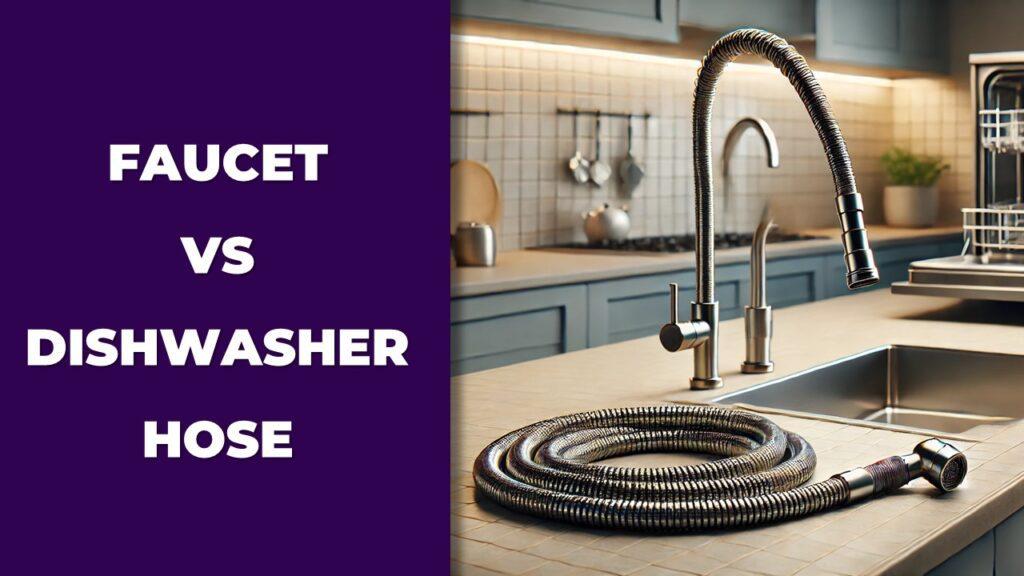
The difference between a faucet hose and a dishwasher hose is in their design and purpose. A faucet hose connects your faucet to the water supply, built for everyday turning on and off. A dishwasher hose handles higher pressure and temperature, used for either supplying water to or draining water from a dishwasher.
In this article, we’ll break down how each hose works, where they’re used, and what sets them apart in terms of materials, size, pressure rating, and installation.
Faucet Hose Vs Dishwasher Hose
Here’s a clear and concise table highlighting the differences between faucet hoses and dishwasher hoses:
| Feature | Faucet Hose | Dishwasher Hose |
| Primary Use | Connects faucets to the water supply for general tasks. | Supplies water to dishwashers during cleaning cycles. |
| Materials | Flexible materials like stainless steel or braided nylon. | Heat-resistant materials like reinforced rubber or polyethylene. |
| Flexibility | Highly flexible for regular adjustments and usage. | Rigid design to handle high water pressure and temperature. |
| Temperature Resistance | Handles cold to moderately warm water. | Built to withstand high-temperature water and detergents. |
| Pressure Handling | Standard water pressure for faucets. | Designed for higher water pressure required by dishwashers. |
| Fittings | Standardized threads compatible with most faucets. | Specialized fittings for dishwasher inlets and water supplies. |
| Connection | Directly connected to faucets and water supply valves. | Requires clamps or adapters for secure connections. |
| Common Applications | Used in kitchens and bathrooms for sinks and faucets. | Used exclusively for dishwashers, including portable models. |
| Lifespan | Longer lifespan with regular use and minimal stress. | Durable under extreme conditions but may need replacement after 5 years. |
| Installation | Easy installation with standard connectors. | More complex, may require clamps or adapters. |
What Is a Faucet Hose?
A faucet hose is a flexible connector that supplies water to a faucet. Commonly found in kitchen and bathroom sinks, these hoses are usually made of materials like stainless steel braiding or reinforced rubber. Their primary purpose is to ensure consistent water flow for everyday tasks like washing dishes, filling pots, or cleaning.
Faucet hoses typically feature:
- Durable materials: Resistant to kinks and minor wear and tear.
- Standardized fittings: Designed to connect seamlessly with most faucet bases and water supply lines.
Recommended Article: Kitchen Faucets for Hard Water
What Is a Dishwasher Hose?
A dishwasher hose, on the other hand, is specifically designed to deliver water to dishwashers during cleaning cycles. These hoses are often made from heat-resistant materials, such as reinforced rubber or polyethylene, capable of handling hot water and detergents without degrading.
Key characteristics of dishwasher hoses:
- Heat resistance: Essential for withstanding high temperatures during wash cycles.
- Secure fittings: Designed for dishwasher inlets and water supply lines to prevent leaks.
Learn more about dishwasher hoses and fittings at Home Depot.
Why Are Faucet Hoses and Dishwasher Hoses Different?
Design and Material Differences
Faucet hoses prioritize flexibility and ease of use. They are often reinforced to prevent kinks, making them ideal for frequent adjustments and regular use. In contrast, dishwasher hoses are more rigid and durable, as they need to handle higher water pressure and extreme temperatures.
Functional Differences
- Faucet hoses are used for direct water flow, such as washing hands or dishes.
- Dishwasher hoses are designed to regulate water flow into the appliance, ensuring it only runs during specific cycles.
How to Install a Faucet Hose
- Turn off the water supply: Shut off the valve under the sink.
- Remove the old hose: Unscrew it from both the faucet base and the water valve.
- Attach the new hose: Securely screw the hose to the faucet and water supply.
- Test for leaks: Turn the water back on and check for dripping. Use plumber’s tape for a tighter seal.
How to Install a Dishwasher Hose
- Turn off the water supply: Ensure no water flows to the dishwasher.
- Connect one end to the dishwasher inlet: Use the hose fitting to secure it tightly.
- Connect the other end to the water line: Screw it into the water valve under the sink.
- Seal the connection: Use clamps or washers to prevent leaks.
- Run a test cycle: Check for leaks during operation.
Connecting a Dishwasher Hose to a Faucet
If you’re using a portable dishwasher, you’ll need an adapter to connect the hose to the faucet:
- Choose the right adapter: Match it to your faucet’s thread size.
- Attach the adapter: Screw it onto the faucet securely.
- Connect the dishwasher hose: Snap or screw it onto the adapter.
- Check for leaks: Turn on the water and run a quick cycle.
Recommended Article: High End Kitchen Faucets
Faucet Thread Sizes vs Dishwasher Hose Fittings
Compatibility Considerations
Faucet hoses generally have standardized thread sizes, making them compatible with most faucets. Dishwasher hoses, however, often require specialized fittings. If your faucet doesn’t fit your dishwasher hose, you’ll need an adapter.
Common Problems in Compatibility
- Leaking connections: Often caused by mismatched threads or loose fittings.
- Pressure issues: An improperly sized hose may not handle water pressure efficiently.
Maintenance Tips for Faucet and Dishwasher Hoses
Maintaining Faucet Hoses
- Inspect for leaks or kinks regularly.
- Replace washers if the connection feels loose or leaks appear.
- Avoid bending the hose too sharply to prevent wear.
Maintaining Dishwasher Hoses
- Check for clogs or leaks periodically.
- Replace hoses that show signs of cracking or bulging.
- Keep connections clean to avoid buildup that could block water flow.
How to Prevent Leaks in Both Hoses
- Use high-quality washers and clamps during installation.
- Avoid overtightening, which can damage threads or fittings.
- Conduct regular inspections to spot wear before it causes significant damage.
What Are the Safety Considerations When Using Hoses?
Pressure Ratings for Faucet vs Dishwasher Hoses
Dishwasher hoses are built to handle higher pressure levels compared to faucet hoses. Using a faucet hose for a dishwasher could result in bursting due to pressure mismatch.
Heat Resistance in Dishwasher Hoses
Dishwasher hoses are made to withstand high temperatures from hot water cycles. Using a faucet hose in this situation could cause material degradation or leaks.
Why Choosing the Right Hose Matters
Using the correct hose for its intended purpose ensures:
- Efficiency: Proper water flow without interruptions.
- Safety: Reduced risk of leaks, bursts, or appliance damage.
- Longevity: Durable performance without premature wear.
Neglecting these factors can result in expensive repairs or even water damage to your home.
Wrapping It Up!
The differences between a faucet hose and a dishwasher hose may seem minor, but they play a critical role in your home’s plumbing. Always ensure you’re using the right hose for the job, and take the time to inspect and maintain them regularly. For more complex installations or troubleshooting, consider consulting a professional plumber to avoid potential risks.
Related FAQs
Can I use a faucet hose for a dishwasher?
No, faucet hoses are not designed to handle high temperatures and pressure like dishwasher hoses. You need a proper dishwasher hose.
How long is a standard dishwasher hose?
Most dishwasher hoses are between 5 to 7 feet long, but they can be extended up to 12 feet if necessary.
Do dishwasher hoses need special fittings?
Yes, dishwasher hoses often require specialized fittings or adapters to connect securely to the water supply and dishwasher inlet.
What materials are faucet and dishwasher hoses made of?
Faucet hoses are typically braided stainless steel or nylon, while dishwasher hoses are made of heat-resistant rubber or polyethylene.
Can I extend a faucet hose or dishwasher hose?
Yes, both hoses can be extended using the correct adapters, but longer hoses may reduce water pressure and efficiency.
How often should I replace a dishwasher hose?
It’s recommended to replace dishwasher hoses every 5 years to prevent leaks or deterioration due to high temperatures and pressure.

Dylan Foster is a family man with years of hands-on experience in plumbing, household maintenance, and fixing everyday issues around the home. A former plumber, Dylan knows what it’s like to deal with tricky leaks, worn-out parts, and all the little problems that pop up in a house. From plumbing repairs to kitchen fixes and garden hose setups, he’s done it all. Dylan shares real-world solutions to help others keep their homes running smoothly and avoid costly mistakes.




